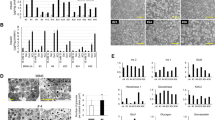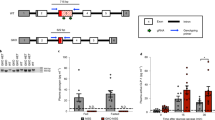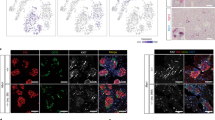Abstract
An alternative approach to the treatment of type I diabetes is the use of genetically altered neoplastic liver cells to synthesize, store and secrete insulin. To try and achieve this goal we modified a human liver cell line, HUH7, by transfecting it with human insulin cDNA under the control of the cytomegalovirus promoter. The HUH7-ins cells created were able to synthesize insulin in a similar manner to that which occurs in pancreatic β cells. They secreted insulin in a regulated manner in response to glucose, calcium and theophylline, the dose–response curve for glucose being near-physiological. Perifusion studies showed that secretion was rapid and tightly controlled. Removal of calcium resulted in loss of glucose stimulation while addition of brefeldin A resulted in a 30% diminution of effect, indicating that constitutive release of insulin occurred to a small extent. Insulin was stored in granules within the cytoplasm. When transplanted into diabetic immunoincompetent mice, the cells synthesized, processed, stored and secreted diarginyl insulin in a rapid regulated manner in response to glucose. Constitutive release of insulin also occurred and was greater than regulated secretion. Blood glucose levels of the mice were normalized but ultimately became subnormal due to continued proliferation of cells. Examination of the HUH7-ins cells as well as the parent cell line for β cell transcription factors showed the presence of NeuroD but not PDX-1. PC1 and PC2 were also present in both cell types. Thus, the parent HUH7 cell line possessed a number of endocrine pancreatic features that reflect the common endodermal ancestry of liver and pancreas, perhaps as a result of ontogenetic regression of the neoplastic liver cell from which the line was derived. Introduction of the insulin gene under the control of the CMV promoter induced changes in these cells to make them function to some extent like pancreatic β cells. Our results support the view that neoplastic liver cells can be induced to become substitute pancreatic β cells and become a therapy for the treatment of type I diabetes.
This is a preview of subscription content, access via your institution
Access options
Subscribe to this journal
Receive 12 print issues and online access
$259.00 per year
only $21.58 per issue
Buy this article
- Purchase on Springer Link
- Instant access to full article PDF
Prices may be subject to local taxes which are calculated during checkout











Similar content being viewed by others
References
Bland BJ (ed). International Pancreas Transplant Registry Newsletter. 2001, p. 13.
Shapiro AMJ et al. Islet transplantation in seven patients with type 1 diabetes mellitus using a glucocorticoid-free immunosuppressive regimen. N Engl J Med 2000; 343:230–238.
Brendel MD, Hering BJ, Schultz AO, Bretzel RG . International Islet Transplant Registry, Vol. 9, 2001.
Tuch BE et al. Recovery of human fetal pancreas after one year of implantation in the diabetic patient. Transplantation 1988; 46: 865–870.
Simpson AM et al. Functional expression of the human insulin gene in a human hepatoma cell line (HEP G2). Gene Ther 1995; 2: 223–231.
Simpson AM et al. Gene therapy of diabetes: glucose-stimulated insulin secretion in a human hepatoma cell line (HEP G2ins/g). Gene Ther 1997; 4: 1202–1215.
Vollenweider F et al. Processing of proinsulin by transfected hepatoma (FAO) cells. J Biol Chem 1992; 267: 14 629–14 636.
Short DK, Okada S, Yamauchi K, Pessin JE . Adenovirus-mediated transfer of a modified human proinsulin gene reverses hyperglycaemia in diabetic mice. Am J Physiol 1998; 275: E748-E756.
Ferber S et al. Pancreatic and duodenal homeobox gene 1 induces expression of insulin genes in liver and ameliorates streptozotocin-induced hyperglycaemia. Nature Medicine 2000; 6: 568–572.
Mitanchez D et al. Regulated expression of mature human insulin in the liver of transgenic mice. FEBS Lett 1998; 421: 285–289.
Lee HC et al. Remission in models of type 1 diabetes by gene therapy using a single-chain insulin analogue. Nature 2000; 408: 483–488.
Kolodka TM, Finegold M, Moss L, Woo SLC . Gene therapy for diabetes mellitus in rats by hepatic expression of insulin. Proc Natl Acad Sci USA 1995; 92: 3293–3297.
Valera A et al. Regulated expression of human insulin in the liver of transgenic mice corrects diabetic alterations. FASEB J 1994; 8: 440–447.
Miyazaki J-I et al. Establishment of a pancreatic beta cell line that retains glucose-inducible insulin secretion: special reference to expression of glucose transporter. Endocrinology 1990; 127: 126–132.
Huang XF, Arvan P . Formation of the insulin-containing secretory granule core occurs within immature β-granules. J Biol Chem 1994; 269: 20 838–20 844.
Duckworth WC . Insulin degradation: mechanisms, products and significance. Endocr Rev 1998; 9: 319–345.
Authier F et al. Endosomal proteolysis of internalized insulin at the C-terminal region of the B chain by cathepsin D. J Biol Chem 2002; 277: 9437–9446.
Terman A et al. Decreased apoptotic response of inclusion-cell disease fibroblasts: a consequence of lysosomal enzyme missorting? Exper Cell Res 2002; 274: 9–15.
Alberts B et al. The Molecular Biology of the Cell. Garland Publishing Inc: New York, 1994, p. 629.
Orci L . Macro- and micro-domains in the endocrine pancreas. Diabetes 1982; 31: 538–565.
Schuit FC, IN'T Veld PA, Pipeleers DG . Glucose stimulates proinsulin biosynthesis by a dose-dependent recruitment of pancreatic beta cells. Proc Natl Acad Sci USA 1988; 85: 3865–3869.
Simpson AM, Tuch BE . Control of insulin biosynthesis in the human fetal beta cell. Pancreas 1995; 11: 48–54.
Carlsson PO, Palm F, Andersson A, Liss P . Markedly decreased oxygen tension in transplanted rat pancreatic islets irrespective of the implantation site. Diabetes 2001; 50: 489–495.
Tuch BE et al. Transplantation of genetically engineered insulin producing hepatocytes into immunoincompetent mice. Transplant Proc 1998; 30: 473.
Orci L . The insulin factory: a tour of the plant surroundings and a visit to the assembly line. Diabetologia 1985; 28: 528–546.
Naya FJ et al. Diabetes, defective pancreatic morphogenesis, and abnormal enteroendocrine differentiation in BETA2/neuroD-deficient mice. Genes Dev 1997; 11: 2323–2334.
Tian YW, Smith PG, Yeoh GC . The oval-shaped cell as a candidate for a liver stem cell in embryonic, neonatal and precancerous liver: identification based on morphology and immunohistochemical staining for albumin and pyruvate kinase isoenzyme expression. Histochem Cell Biol 1997; 107:243–250.
Leibowitz G et al. IPF1/PDX1 deficiency and beta-cell dysfunction in Psammomys obesus, an animal with type 2 diabetes. Diabetes 2001; 50:1799–1806.
Koina ME, Simpson AM, Tuch BE, Marshall GM . Inducible insulin expression in two human hepatoma cell lines. Proc Aust Diabetes Soc 1998; 134: (Abstract P15).
Sirica AE, Gainey TW, Mumaw VR . Ductal hepatocytes. Evidence for a bile ductular cell origin in furan-treated rats. Am J Pathol 1993; 145: 375–383.
Elmore LW, Sirica AE . Phenotypic characterization of metaplastic intestinal glands and ductular hepatocytes in cholangiofibrotic lesions rapidly induced in the caudate liver lobe of rats treated with furan. Cancer Res 1991; 51: 5752–5759.
Rao MS, Subbaraq V, Reddy JK . Induction of hepatocytes in the pancreas of copper-depleted rats following copper depletion. Cell Differ 1986; 18: 109–117.
Dabeva MD, Shafritz DA . Activation, proliferation and differentiation of progenitor cells in to hepatocytes in the D-galactosamine model of liver regeneration. Am J Pathol 1993;143: 1606–1620.
Konishi N, Ward JM, Waalkes MP . Pancreatic hepatocytes in Fischer and Wistar rats induced by repeated injections of cadmium chloride. Toxicol Appl Pharmacol 1990;18: 678–686.
Monti LD et al. Intravenous infusion of diarginyl insulin an insulin, analogue – effects on glucose turnover and lipid levels in insulin-treated type-II diabetic patients. Metab – Clin Exp 1992;41:540–544.
Matchinsky FM, Glaser B, Magnuson MA . Pancreatic β-cell glucokinase: closing the gap between theoretical concepts and experimental realities. Diabetes 1998; 47: 307–315.
Hughes SD, Johnson JH, Quaade C, Newgard CB . Engineering of glucose-stimulated insulin secretion and biosynthesis in non-islet cells. Proc Natl Acad Sci USA 1992; 89: 688–692.
Simpson AM et al. Transformation of pituitary and fibroblast cell lines using human insulin cDNA and a dexamethasone-inducible promoter. Transplant Proc 1993; 25: 2915–2916.
Tuch BE, Maitland JE, Turtle J . Culture and perifusion of human fetal pancreas. In: Larner J, Pohl S (eds). Methods in Diabetes Research. Vol. 1: Laboratory Methods, Part B. John Wiley & Sons: New York, 1984. pp 153–163.
Maldonato A, Renold AE, Sharp GWG, Cerasi E . Glucose-induced proinsulin biosynthesis. Diabetes 1977; 26: 538–545.
Chomczynski P, Sacchi N . Single-step method of RNA isolation by acid guanidinium thiocyanate–phenol–chloroform extraction. Anal Biochem 1987; 162: 156–159.
Noonan KE et al. Quantitative analysis of MDR1 (multidrug resistance) gene expression in human tumours by polymerase chain reaction. Proc Natl Acad Sci USA 1990; 87: 7160–7164.
Tanizawa Y, Koranyi LI, Welling CM, Permutt MA . Human liver glucokinase gene: cloning and sequence determination of two alternatively spliced cDNAs. Proc Natl Acad Sci USA 1991; 88: 7294–7297.
Tuch BE, Chen J . Resistance of the human fetal β cell to the toxic effect of multiple low dose streptozotocin. Pancreas 1993; 8: 305–311.
Tuch BE, Osgerby KJ, Turtle JR . Normalization of blood glucose levels in nondiabetic nude mice by human fetal pancreas after induction of diabetes. Transplantation 1988; 46: 608–611.
Simeonovic CJ, Brown DJ, Teirrinen KUS, Wilson JD . Preparation and transplantation of fetal proislets. In: Ricordi C (ed). Pancreatic Islet Cell Transplantation. RG Landes Co: Austin, TX, 1992, pp 238–248.
Davalli AM et al. Function, mass, and replication of porcine and rat islets transplanted into diabetic nude mice. Diabetes 1995; 44: 104–111.
Tuch BE, Roberts EC, Darby KB . Release of proinsulin from the human fetal beta cell. J Endocrinol 1992; 132: 159–67.
Bradford MM . A rapid and sensitive method for the quantitation of microgram quantities of protein utilising the principle of protein-dye binding. Anal Biochem 1976; 72: 248–254.
Swan MA . Improved preservation of ultrastructural morphology in human spermatozoa using betaine in the primary fixative. Int J Androl 1997;20: 45–54.
Saccomanno K et al. Immunoelectron microscopy: a new method for detection of insulin antibodies. J Histochem Cytochem 1993; 41: 1233–1239.
Gross DJ, Leibowitz G, Cerasi E, Kaiser N . Increased susceptibility of islets from diabetes-prone Psammomys obesus to the deleterious effects of chronic glucose exposure. Endocrinology 1996; 137: 5610–5615.
Hintze JL . Number Cruncher Statistical System: Version 5.01. Kaysville, Utah, 1991.
Acknowledgements
This work was supported by a Project Grant from the National Health and Medical Research Council of Australia. Three of the authors were recipients of Postgraduate Scholarships, one from the University of Technology, Sydney (BZ); one from The University of New South Wales (MTT); and one an Australian Postgraduate Award from the Department of Education, Training and Youth Affairs, Australia (RKBH). We wish to thank Dr Murray Smith for his constructive comments on the manuscript, Dr Anil Amaratunga, Mr Appavoo Mathiyalagan and Dr Chang Tao for technical assistance with Western blots, Mrs Pauline Khoury for assistance with the transplants, Ms Robyn Baum and Ms Lillian Tan for technical assistance with the proinsulin and C-peptide assay, and Mr Roland Smith, Anatomy, Sydney University for printing the electron micrographs in Figures 6 and 7a–c.
Author information
Authors and Affiliations
Rights and permissions
About this article
Cite this article
Tuch, B., Szymanska, B., Yao, M. et al. Function of a genetically modified human liver cell line that stores, processes and secretes insulin. Gene Ther 10, 490–503 (2003). https://doi.org/10.1038/sj.gt.3301911
Received:
Accepted:
Published:
Issue Date:
DOI: https://doi.org/10.1038/sj.gt.3301911
Keywords
This article is cited by
-
Reversal of diabetes following transplantation of an insulin-secreting human liver cell line: Melligen cells
Molecular Therapy - Methods & Clinical Development (2015)
-
The use of β-cell transcription factors in engineering artificial β cells from non-pancreatic tissue
Gene Therapy (2015)
-
Huh-7 cell line as an alternative cultural model for the production of human like erythropoietin (EPO)
Journal of Translational Medicine (2011)
-
Glucose- and Metabolically Regulated Hepatic Insulin Gene Therapy for Diabetes
Pharmaceutical Research (2008)
-
Long-term correction of diabetes in rats after lentiviral hepatic insulin gene therapy
Diabetologia (2007)



